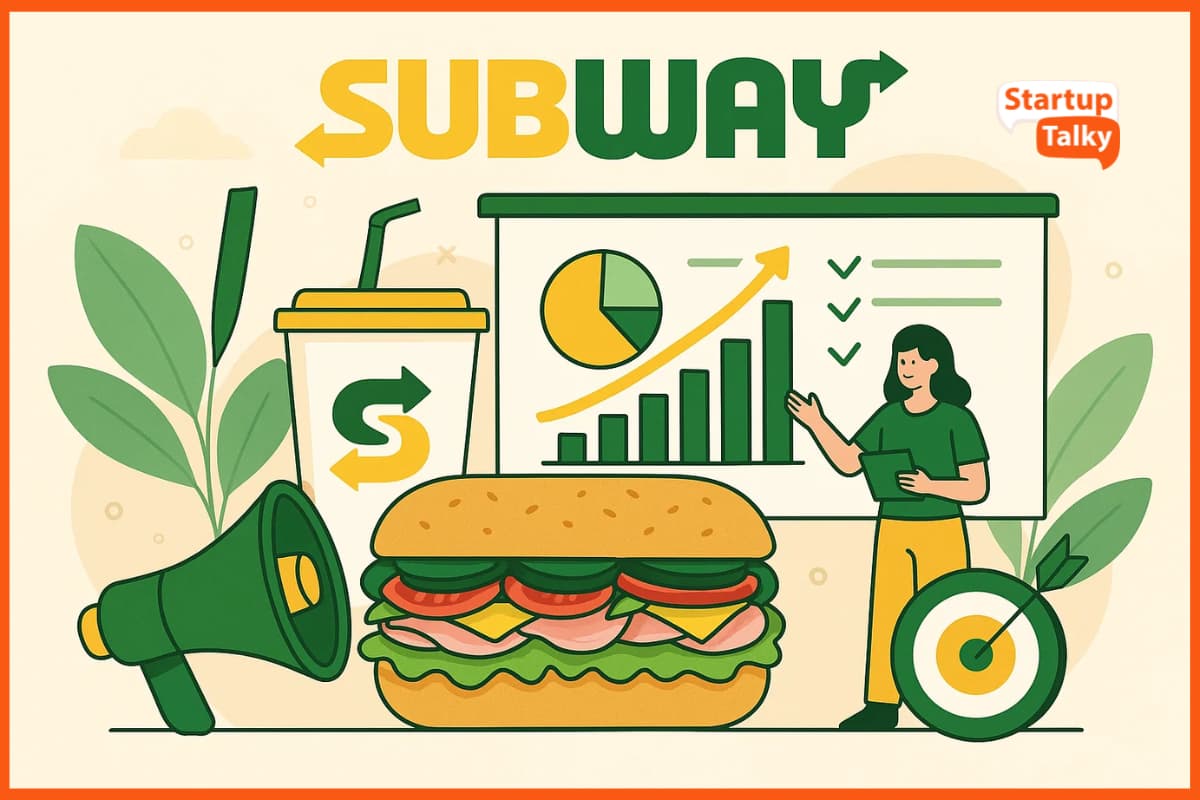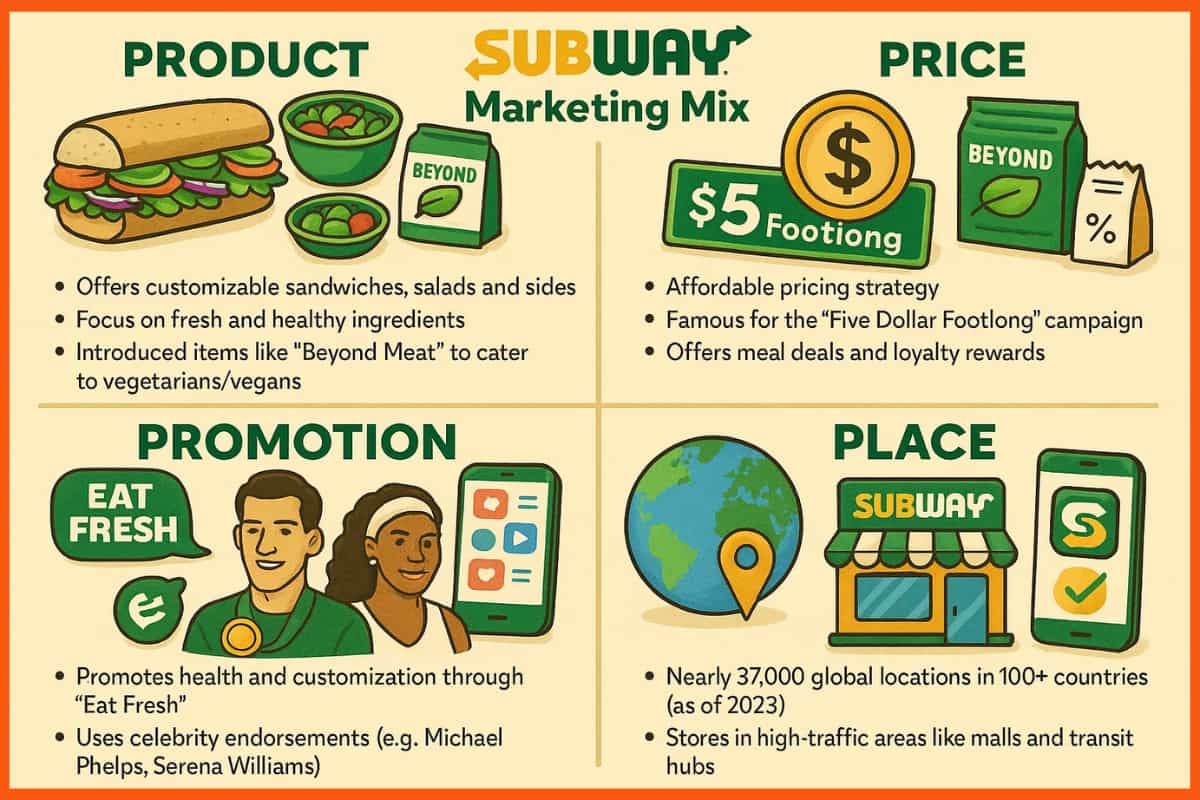Subway Marketing Strategy: Complete Guide to Subway Marketing, Pricing, Advertising, Campaigns, and Business Plan
🔍Insights
Subway, the world's largest sandwich chain, has revolutionized the fast-food industry with its healthy and customizable sandwiches. With over 45,000 locations in over 100 countries, Subway has become a global brand with a loyal customer base.
The journey of Subway started in 1965 when Fred DeLuca, a 17-year-old high school graduate, opened the first store in Bridgeport, Connecticut, with a loan of $1,000 from his friend, Peter Buck. Initially, the store was named Pete’s Super Submarines, but later, they decided to change it to Subway.
The early years were challenging for Subway, and it wasn’t until the 1980s that the company began to expand rapidly. The introduction of the “Subway Club” in 1985 and the “Five Dollar Footlong” campaign in 2007 further boosted Subway’s sales and market share.
As of 2024, Subway reported approximately $9.51 billion in U.S. sales, while continuing to grow globally. By the end of 2023, Subway operated nearly 37,000 restaurants worldwide across more than 100 countries. The brand achieved positive global net restaurant growth for the second year in a row, driven by strong international expansion and over 1,000 new global openings.
Subway’s achievements are not limited to its sales figures; the company has also won several awards for its healthy and nutritious menu options. In 2014, Subway became the first fast-food chain to remove all artificial flavors, colors, and preservatives from its sandwiches. The company has also been recognized for its sustainable practices and environmental initiatives.
Despite facing stiff competition from other fast-food chains, Subway has maintained its position as the largest sandwich chain globally. The company has adapted to changing consumer trends by introducing new menu items and expanding its digital and delivery services. Subway business strategy focuses on offering customizable, healthy meals at affordable prices while expanding its global presence and improving digital customer experiences.
Subway’s story is an inspiring one. From humble beginnings, the company has grown to become a global brand, known for its healthy sandwiches and sustainable practices. With its innovative marketing strategies and commitment to providing fresh and nutritious food, Subway is sure to remain a dominant player in the fast-food industry for years to come.

Subway Target Market
Subway Marketing Mix
Subway Marketing Campaigns
Subway Marketing Strategies
Subway Target Market
The company has always been committed to providing fresh and nutritious food options, catering to health-conscious consumers who are looking for a quick meal that won’t compromise their dietary goals.
Subway’s target audience is diverse, ranging from teenagers to adults. The company’s customizable menu options make it a popular choice for families with children who have varying taste preferences. The chain’s low-calorie options also attract health-conscious individuals, including those on special diets such as vegetarians and those with gluten intolerances.
The target audience consists of individuals who value customization and control over their meal choices. They appreciate being able to choose from a wide range of bread, meat, and veggie options to create a sandwich that meets their unique taste preferences. They also prioritize convenience and speed, preferring a quick meal that they can grab and go.
Subway has a global reach, with locations in both urban and suburban areas. The chain’s accessibility makes it a convenient choice for people who are always on the go, whether they’re commuting to work or traveling.
Subway Marketing Mix
Subway, the world’s largest sandwich chain, has become a household name by offering customizable and healthy sandwich options to its customers. The company’s success can be attributed, in part, to its effective marketing mix, which includes a combination of product, price, promotion, and place.

Subway Product Strategy
Subway’s menu includes a variety of sandwiches, salads, and sides that can be customized to meet individual taste preferences. The company's focus on fresh and nutritious ingredients sets it apart from other fast-food chains. In addition, Subway has introduced innovative products, such as the “Beyond Meat” sandwich, to cater to vegetarian and vegan customers.

Subway Pricing Strategy
Subway’s pricing strategy has been to offer affordable options for its customers. The company’s “Five Dollar Footlong” campaign, which offered select sandwiches at a discounted price, was a huge success and helped increase the company’s market share. Subway also offers meal deals and rewards programs to incentivize repeat customers.
Subway Promotion Strategy
Subway’s promotion strategy has been to emphasize its healthy and customizable menu options. The company’s “Eat Fresh” campaign and celebrity endorsements, such as Michael Phelps and Serena Williams, have helped to create a positive brand image. Subway also uses social media and mobile apps to engage with customers and promote its products.
Subway Eat Fresh
Subway Place Strategy
Subway has an extensive global presence, with over 45,000 locations in over 100 countries. The company’s strategy has been to open stores in convenient locations, such as shopping centers and transportation hubs, to cater to customers on the go. Subway has expanded its digital and delivery services to make its products more accessible.
Subway's marketing mix has been instrumental in the company's success. By offering fresh and customizable products at an affordable price, promoting its healthy image, and opening stores in convenient locations, Subway has been able to cater to the needs of its diverse customer base. The company's focus on sustainability and innovation has also helped to differentiate itself from its competitors. As Subway continues to adapt to changing consumer trends, its marketing mix will continue to be a crucial factor in its success.

Subway Marketing Campaigns
Subway has launched several successful marketing campaigns over the years, but two of its most memorable and successful campaigns are the “Five Dollar Footlong” and “Eat Fresh” campaigns.
The “Five Dollar Footlong” campaign was launched in 2008 and offered select sandwiches for a discounted price of $5. The campaign was a huge success and helped increase Subway’s market share. The catchy jingle, “Five Dollar Footlong”, became an iconic slogan and was widely recognized by customers. The campaign was so successful that it was relaunched several times over the years.
Subway Five-Dollar Footlong Commercial
The “Eat Fresh” campaign was launched in 2005 and focused on promoting Subway’s fresh and healthy menu options. The campaign included celebrity endorsements, such as Michael Phelps and Serena Williams, and emphasized Subway’s commitment to using fresh and nutritious ingredients. The campaign helped to create a positive brand image for Subway and reinforced its position as a healthy fast-food option.
Subway "Eat Fresh"
Both campaigns helped to establish Subway as a leading global sandwich chain and were instrumental in its success. The catchy slogans and celebrity endorsements helped to create a strong brand image, while the emphasis on fresh and healthy ingredients appealed to health-conscious consumers.
Subway Marketing Strategies
Subway, the world’s largest sandwich chain, has established itself as a leading player in the fast-food industry with its innovative marketing strategies. From product innovation to social responsibility, Subway’s marketing strategies have helped the company to stay relevant and appeal to a diverse customer base. Here are the top 8 marketing strategies that have contributed to Subway’s success:
Product Innovation
Subway regularly introduces new products to its menu to keep up with changing consumer trends. The company’s focus on fresh and nutritious ingredients sets it apart from other fast-food chains, and it has also introduced innovative products, such as the “Beyond Meat” sandwich, to cater to vegetarian and vegan customers.
Digital Marketing
Subway uses digital marketing to engage with customers and promote its products. The company has a mobile app that allows customers to place orders and earn rewards. Subway also uses social media platforms such as Facebook, Twitter, and Instagram to connect with customers and share updates on new products and promotions.

Social Responsibility
Subway has committed to sustainability and social responsibility. The company has implemented initiatives such as using locally sourced ingredients, reducing waste, and supporting communities through its Subway Cares program. These initiatives not only demonstrate Subway’s commitment to social responsibility but also appeal to customers who prioritize sustainability.

Celebrity Endorsements
Subway has used celebrity endorsements to promote its brand and products. For example, the company has partnered with athletes such as Michael Phelps and Serena Williams to promote its healthy image. These partnerships not only help to create a positive brand image but also appeal to customers who aspire to the healthy lifestyles of their favorite athletes.
Customization
Subway’s focus on customization has been a key factor in its success. Customers can choose from a variety of bread, meats, vegetables, and sauces to create a sandwich that meets their taste preferences. This focus on customization has helped Subway to appeal to a diverse customer base.

Price Promotions
Subway has used price promotions, such as the “Five Dollar Footlong” campaign, to increase sales and attract customers. These promotions have been successful in creating buzz and driving traffic to Subway stores.
Loyalty Programs
Subway knows that loyalty programs help keep customers coming back without spending too much on new ads. That’s why it created its own program called Subway MyWay Rewards.
When customers join, they earn tokens or points every time they buy something from a Subway store, website, or app. Sometimes, they get extra tokens for special offers or when they order through the app.
These tokens can be used to get discounts on future purchases. Usually, 200 tokens equal $2 in Subway cash, but this may change with different offers.
Convenience
Subway has opened stores in convenient locations, such as shopping centers and transportation hubs, to cater to customers on the go. The company has also expanded its digital and delivery services to make its products more accessible.
Seasonal And Limited-time Products
Subway offers seasonal and limited-time products to keep customers engaged and interested. These products create a sense of urgency and encourage customers to try new products.
Conclusion
Subway’s marketing strategies have been instrumental in the company’s success. By focusing on product innovation, digital marketing, social responsibility, celebrity endorsements, customization, price promotions, convenience, and seasonal and limited-time products, Subway has been able to appeal to a diverse customer base and stay relevant in the fast-food industry. As Subway continues to evolve and adapt to changing consumer trends, its marketing strategies will continue to be a crucial factor in its success.
The focus on customization has also been a key factor in its success. By allowing customers to create sandwiches that meet their taste preferences, Subway has been able to appeal to a wide range of customers with different dietary needs and preferences.
Looking ahead, Subway will need to continue to adapt to changing consumer trends and preferences. The company’s emphasis on digital marketing and convenience will be particularly important in the post-pandemic world, as customers increasingly rely on online ordering and delivery services.
Subway’s marketing strategies are a testament to the company’s ability to innovate and stay relevant in the fast-food industry. As Subway continues to evolve and adapt, its marketing strategies will undoubtedly play a crucial role in its future success.
Marketers and start-ups can learn a lot from Subway’s marketing strategies. Subway’s success is not just the result of its product offerings, but also its ability to adapt and innovate in response to changing consumer trends and preferences.
So, what are you waiting for? Gear up and plan marketing strategies for your company!
FAQs
What is Subway target audience?
Subway’s target market is diverse, ranging from teenagers to adults. The company’s customizable menu options make it a popular choice for families with children who have varying taste preferences. The chain’s low-calorie options also attract health-conscious individuals, including those on special diets such as vegetarians and those with gluten intolerances.
What are the top marketing strategies used by Subway making it the largest sandwich chain?
Here are the top marketing strategies used by Subway -
- Product Innovation
- Digital Marketing
- Social Responsibility
- Celebrity Endorsements
- Customization
- Price Promotions
- Convenience
- Seasonal And Limited-time Products
What is Subway advertising strategy?
Subway's advertising strategy focuses on promoting healthy, customizable food using slogans like "Eat Fresh," celebrity endorsements, and digital marketing through apps and social media.
How does Subway market their products?
Subway markets its products through TV ads, celebrity endorsements, social media, mobile apps, and in-store promotions highlighting freshness and customization.
What is Subway marketing plan?
Subway’s marketing plan focuses on promoting fresh, customizable food through affordable pricing, loyalty programs, digital engagement, and global brand visibility.
Which is the best Subway marketing campaign?
Subway’s marketing campaign highlights “Eat Fresh,” using celebrity endorsements, limited-time offers, and digital platforms to promote healthy, customizable meals.
Must have tools for startups - Recommended by StartupTalky
- Convert Visitors into Leads- SeizeLead
- Website Builder SquareSpace
- Manage your business Smoothly Google Business Suite








